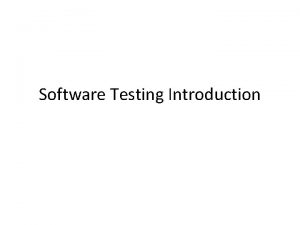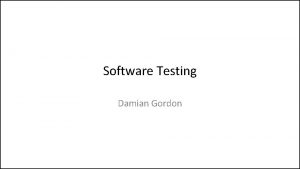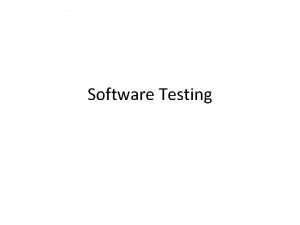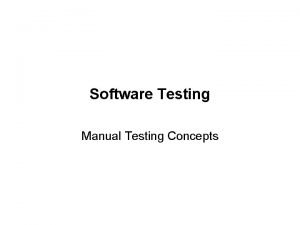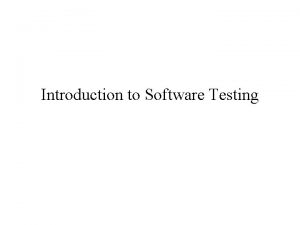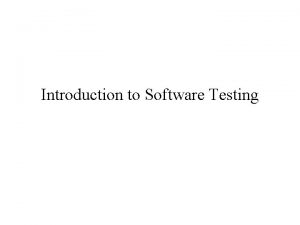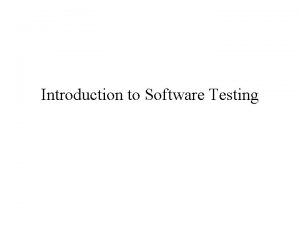Introduction to Software Testing Software Testing Testing is









- Slides: 9

Introduction to Software Testing

Software Testing • Testing is the process of detecting errors by running the actual software and verifying that it works as it should – Test cases, Expected results, Actual results • Testing is by far the most popular QA activity (but not the most effective) • Technical reviews (design reviews, code reviews, etc. ) are cheaper and more effective than testing, but are often not done • Research has shown that all forms of testing combined usually find less than 60% of the errors present

Software Testing • There are many different types of testing. Three of the most important are: – Unit Testing: testing individual modules (e. g. , classes) to make sure they work in isolation before combining them with the rest of the system – Integration Testing: testing the combination of multiple modules after they have been integrated together • If the individual modules work in isolation, can there possibly be defects in their combination? • YES! The interactions between the modules can contain defects – System Testing: testing done on the entire program, after it is completely integrated

Software Testing • Exhaustively testing software is not feasible – The number of possible input combinations is effectively infinite – The number of unique paths through the code is effectively infinite – You might not live long enough to exhaustively test a non-trivial software system • We must do partial testing because we only have enough resources (time and money) to run relatively few test cases • Partial testing can never prove the absence of defects – If the system passes all your test cases, there could still be defects, you just need more or better test cases to find them

Software Testing • Effective testing lies in intelligently choosing the relatively few test cases that will actually be executed – Test all requirements and features defined in the requirements spec. and functional spec. – Test cases should not be redundant (i. e. , each one should follow a different path through the code) – Focus on scenarios that users are likely to encounter in practice – Analyze the program’s design and code to find potential weak areas – Analyze all points at which data enters the system and look for ways to attack it

Software Testing • Approaches to test case design are generally divided into two broad categories: Black Box Testing and White Box Testing • Black Box Testing – The tester has limited knowledge of the inner workings of the item being tested – Test cases are based on the specification of the item's external behavior – Can be done at the Unit, Integration, and System levels • White Box Testing – The tester has knowledge of the inner workings of the item being tested – Test cases are based on the specification of the item's external behavior AND knowledge of its internal implementation – Most commonly done at the Unit level

Software Testing • Testing is unlike other software development activities because the goal is to break the software rather than to create it • Effective testing requires an assumption that defects actually exist, and a desire to find them • If you think you won't find defects, or you don't want to, you won’t be effective in your testing • Testing by both developers and an independent testing group are essential – They have different perspectives and motivations – They do different kinds of tests (developers do white box, test team does black box), which tend to discover different types of defects

Software Testing • Defects are not evenly distributed (i. e. , they tend to cluster) • Research has shown that: – 80% of a system's defects are found in 20% of its code – 50% of a system's defects are found in 5% of its code • There is a high correlation between bugs and complex code. – Use tools to measure code complexity, and focus testing on those modules with the most complex code • One goal of testing is to identify the most problematic modules – Redesign may be needed if there is an inherent design flaw – Or, replace buggy module with a third-party library/product

Software Testing • Automation of test cases is essential to make frequent re-running of test cases feasible • Create programs whose purpose is to test other programs • Inventing ways to automate test cases can be interesting and challenging work that requires lots of software design and coding (sometimes called “Test Engineering”) • Some tests are difficult to automate and must be run manually
 Domain testing in software testing
Domain testing in software testing Logic based testing
Logic based testing Du path testing
Du path testing What is globalization testing
What is globalization testing What is testing
What is testing Control structure testing in software engineering
Control structure testing in software engineering Decision table testing in software testing
Decision table testing in software testing Advantages and disadvantages of decision table
Advantages and disadvantages of decision table Extended entry decision table
Extended entry decision table Rigorous testing in software testing
Rigorous testing in software testing











